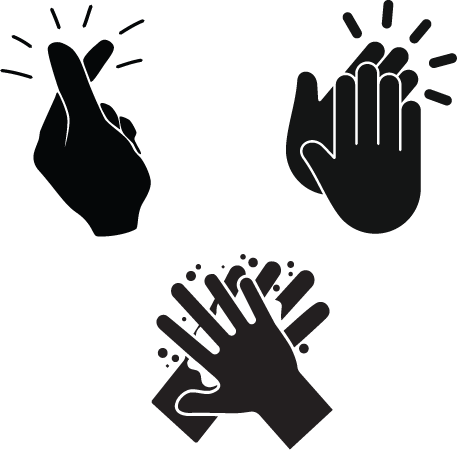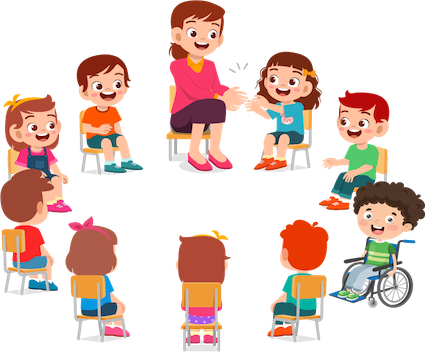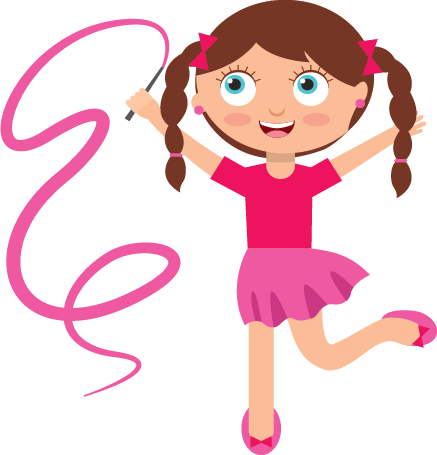
Prep. Lesson 25. Body percussion
- Woodblock Difficulty:
 Prior learning: None
Prior learning: None

Body percussion is the technique of using the body to make different sounds. Four main audible sounds can be produced with body percussion:
- Clicking (or snapping)
- Clapping (or tapping)
- Patting and slapping (patsch)
- Stamping (or stomping)
Note: At this year level, clicking may be hard to perform. Substitute any other body percussion movement if desired.
![]() Students will develop their listening skills, coordination, and ability to replicate sounds through interactive body percussion.
Students will develop their listening skills, coordination, and ability to replicate sounds through interactive body percussion.
 Success Criteria
Success Criteria
- I can watch and listen carefully to the leader's actions.
- I can copy the sounds and movements using my body percussion.
- I can stay focused and participate actively in the activity.
- Arrange the students in a circle with enough space for movement. Stand in the centre.
- Explain the activity: "We are playing 'Copy Cat.' Your job is to watch, listen, and copy the sounds and actions I make."
- Begin with a simple movement, such as raising your right leg slightly and stamping it on the ground. Ask the students to replicate it.
- Repeat the action once or twice to ensure everyone is engaged and following.
- Switch to your left leg and stamp, ensuring the students imitate correctly.
- Introduce a second body percussion action, such as clapping hands, patting your head, or slapping your knees. Repeat until students successfully mimic it.
- Gradually add more complex sequences, combining different movements and sounds to challenge their coordination and focus.
- Once students are proficient, invite a volunteer to lead the group. Offer encouragement and guidance as needed.
- Rotate the leader's role to give multiple students a chance to build confidence and engage more deeply in the activity.
![]() Students will use body percussion to perform rhythmic patterns in time with a familiar song.
Students will use body percussion to perform rhythmic patterns in time with a familiar song.
 Success Criteria
Success Criteria
- I can perform rhythmic patterns using clapping, slapping knees, and stamping feet in time with the song.
- I can stay focused and participate actively throughout the activity.
- I can create and share my own rhythmic pattern to match the song.

![]() Lyrics
Lyrics
Goodnight, sleep tight.
Friends will come tomorrow night.
- Start by singing Goodnight together with students and ensure everyone is secure.
- Demonstrate a simple rhythmic pattern using body percussion, such as clapping twice, slapping knees once, and stamping feet twice. Perform the pattern in time with the beat of the song.
- Repeat the pattern several times as you sing, encouraging students to join when they feel ready.
- Gradually increase their confidence by singing and performing the body percussion together.
- Once students are comfortable, change the pattern slightly, such as clapping once, slapping knees twice, and stamping feet once. Then, perform the new pattern with the song and invite students to follow along.
- As students gain confidence, invite a volunteer to create their own rhythmic pattern using clapping, slapping knees, and stamping feet.
- Sing the song again, using the student’s pattern as the accompaniment. Rotate through several volunteers, allowing multiple students to lead and share their patterns.
- Finish by singing the song one last time, either with the original pattern or a favourite one created by the class.
- Reflect on how body percussion enhances the song, and praise the students for their creativity. Encourage them to think of other songs in which they could create their own body percussion rhythms.
![]() Students will explore sound imitation using body movements and percussion to create various sensory experiences.
Students will explore sound imitation using body movements and percussion to create various sensory experiences.

- Begin with animal Sounds. Demonstrate flapping your arms gently like wings while softly clapping to mimic a bird’s movement and sound. Encourage the students to join in.
- Experiment with other animals: stomp like an elephant, pat your legs quickly for a galloping horse, or rub your hands together to mimic a snake’s hiss.
- Ask students to develop their own animal ideas and imitate their sounds and movements.
- Explain that students will now create a rainstorm using body percussion.
- Start by softly tapping your fingers on your desk or the floor to represent light raindrops. Gradually increase the intensity by clapping your hands to imitate heavier rain. Finish with stomping your feet to mimic thunder. Encourage students to listen to how the sound grows and fades, emphasising dynamics.
- Conclude with the heartbeat rhythm. Place your hand over your chest and gently pat to mimic the sound of a heartbeat.
- Begin with a steady rhythm, like "lub-dub, lub-dub." Invite students to join in, starting slow and experimenting with different speeds to mimic a calm or excited heartbeat.
 Success Criteria
Success Criteria
- I can combine body movements with sounds to imitate animals.
- I can use my hands and feet to create the sounds of a rainstorm.
- I can gently pat my chest to mimic a heartbeat rhythm.
![]()
Students will explore and experiment with creating different sounds using their hands to develop their sense of creativity and rhythm.

 Success Criteria
Success Criteria
- I can discover and create a variety of sounds using my hands.
- I can experiment with different ways of using my hands to make unique sounds.
- I can share the sounds I create with my classmates.
- Ask the students, “How many different sounds do you think you can make using just your hands?”
- Explain that they’ll experiment to find as many unique sounds as possible.
- Begin by demonstrating a few examples. Start with a basic clap. To create different tones, try variations such as soft claps, loud claps, or clapping with cupped hands.
- Show them how to snap their fingers, or suggest rubbing them together if snapping is too difficult.
- Use fingertips to gently tap on their palms, tables, or legs to produce light tapping sounds.
- Rub their palms together quickly to create a soft swishing sound.
- Flick a finger against their palm for a sharp, clicking noise.
- Encourage students to explore other possibilities, such as clapping the backs of their hands, slapping their thighs with one hand, or combining sounds like a clap followed by a tap.
- Ask them to practice and discover their own unique sounds, giving them a few minutes to experiment.
- Afterward, invite students to share their created sounds with the group. Encourage them to describe how they made their sound and what it reminds them of.
- Finish by creating a group rhythm. Use the sounds the students discovered to compose a short rhythmic pattern together. Then, lead the group in performing it as a mini "hand symphony," taking turns incorporating their creative sounds. Celebrate their discoveries and teamwork!
![]() Students will develop their ability to follow and replicate rhythmic patterns by participating in a group activity.
Students will develop their ability to follow and replicate rhythmic patterns by participating in a group activity.

 Success Criteria
Success Criteria
- I can observe and accurately replicate the leader's rhythmic pattern.
- I can take turns leading and following in the activity.
- I can work together with my classmates to keep the rhythm in time.
- Start by arranging the students in a line or circle, ensuring everyone can see and hear the leader.
- Choose one student to be the first leader.
- Demonstrate creating a simple pattern using body percussion, such as clapping, slapping knees, or stomping feet.
- Encourage the leader to start with a simple rhythm so everyone can follow easily.
- The leader performs their pattern, and the rest of the group copies it in unison.
- Emphasise the importance of observing closely and staying in time with the leader.
- After a few repetitions, rotate to a new leader, allowing each student to create their own pattern.
- Once everyone has had a turn, increase the challenge by encouraging leaders to create more complex patterns or include dynamic changes, such as faster or softer rhythms.
- If the group is ready, experiment with adding movement by having the leader walk in a circle or around the room while performing their pattern, with the rest of the group following behind like a train.
![]() Students will explore combining scarves with body percussion to enhance their understanding of rhythm and movement.
Students will explore combining scarves with body percussion to enhance their understanding of rhythm and movement.

 Success Criteria
Success Criteria
- I can wave a scarf in time with clapping or stomping.
- I can combine scarf movements with body percussion to create a rhythm.
- I can participate actively and stay focused during the activity.
- Begin by giving each student a lightweight scarf or piece of fabric.
- Demonstrate how scarves can move differently, such as by waving them slowly or quickly, in circles, or up and down.
- Encourage students to practice these motions freely to become familiar with the movement.
- Explain that they will now combine scarf movements with body percussion. Start with a simple example, such as clapping while waving the scarf up and down.
- Perform the action in time with a steady beat, and ask the students to join in once they feel ready.
- Gradually introduce more complex combinations.
- Stomping while moving the scarf in circles.
- Clapping and waving the scarf from side to side.
- Alternating between stomping and clapping while changing the scarf’s movement (e.g., up-down for clapping and side-to-side for stomping).
- Encourage creativity by allowing students to invent their own combinations of scarf movements and body percussion. Invite volunteers to demonstrate their ideas for the class and have everyone try to follow along.
- To finish, play a familiar song and have the students perform their scarf movements and body percussion in time with the music. Encourage them to keep their actions rhythmic and synchronised with the beat.
Suggested lessons
Y1. Beat II

Y1. Beat III

Y1. Beat IV

